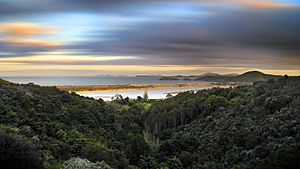Ngunguru facts for kids
Quick facts for kids
Ngunguru
|
|
|---|---|

Ngunguru coast
|
|
| Country | New Zealand |
| Region | Northland Region |
| District | Whangarei District |
| Ward | Whangarei Heads Ward |
| Electorates |
|
| Area | |
| • Total | 3.57 km2 (1.38 sq mi) |
| Population
(June 2023)
|
|
| • Total | 1,270 |
| • Density | 355.7/km2 (921/sq mi) |
Ngunguru is a cool coastal town in Northland, New Zealand. It's about 26 kilometers (16 miles) north-east of Whangārei. The Ngunguru River flows past the town and a long, sandy strip of land called a sandspit. It all empties into Ngunguru Bay. Nearby towns to the north include Tutukaka and Matapouri. Right off the coast are the amazing Poor Knights Islands. These islands are a special protected area for sea life, like a giant underwater park!
The name Ngunguru comes from the Māori-language and means 'rumbling tides'.
Contents
Ngunguru's Past: A Journey Through Time
Ngunguru has a long and interesting history! Long ago, a large canoe named Tūnui-ā-rangi visited this area. This waka brought the Ngāi Tāhuhu people to New Zealand. Another waka captain, Puhi, from the Mataatua canoe, gave the area its name.
Before Europeans arrived, many Māori people lived here. In 1832, a big battle happened on the Ngunguru sandspit. It was fought between the local Te Waiariki tribe and the Waikato tribes, led by Te Wherowhero.
Early European Settlers
The first map of "Nongodo" (Ngunguru) was drawn in 1836 by Captain N. C. Phillips. In 1840, some early settlers bought a huge piece of land here. They built one of the first sawmills in New Zealand at Ngunguru. This mill used water power to cut down giant kauri trees. Ngunguru became famous for exporting timber and roofing shingles.
In 1860, a ship called the Southern Cross was wrecked in Ngunguru Bay. Later, in the 1860s, a track was built to connect Ngunguru to Whangarei.
Coal and Community Growth
In 1892, people discovered coal near the Ngunguru River. Over 620,000 long tons of coal were mined until 1921!
Ngunguru became a popular beach town after roads improved in the 1950s. In 2005, there was a plan to sell the Ngunguru sandspit for building houses. But many local people didn't want this to happen. In 2011, the government bought the sandspit to protect it. Now, the Department of Conservation looks after this special place. It's one of the few sandspits that are still natural and untouched.
In 2022, the Scotland women's national rugby team visited Ngunguru Marae. This visit celebrated the connections between Scotland and Māori culture.
Who Lives in Ngunguru?
Ngunguru covers about 3.57 square kilometers (1.38 square miles). In 2023, about 1,173 people lived here. The population has grown quite a bit since 2013!
- There are almost equal numbers of males and females.
- The average age of people in Ngunguru is about 46 years old.
- About 19% of the people are under 15 years old.
- About 25% of the people are 65 years or older.
Different Cultures in Ngunguru
People in Ngunguru come from many different backgrounds:
- About 88% are European (Pākehā).
- About 20.7% are Māori.
- Smaller numbers of people are Pasifika, Asian, or from other parts of the world.
Most people (98.5%) speak English. About 4.9% speak the Māori language. Many people also speak other languages.
When it comes to beliefs, about 65.7% of people said they had no religion. About 22.3% are Christian, and smaller numbers follow other religions like Hinduism, Islam, or Māori beliefs.
What Can You Do in Ngunguru?
Ngunguru has some great places for kids and families!
Ngunguru School
Ngunguru School is a primary school for students from Year 1 to Year 8 (ages 5-13). It has about 170 students. The school celebrated its 100th birthday in 1970!
Sports and Recreation Club
Ngunguru has a fantastic sports and recreation club. It started in the late 1970s. The club officially opened its sports ground in 1982 with a big party and a rugby game. Even some famous former All Blacks (New Zealand's national rugby team) played in that game! It's a great place for sports and fun activities.


